
|
Films of All-Time 1987-1989 |
| Film Title/Year, Director | |||||||||||||||||||||||||||||
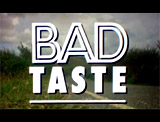
|
Bad Taste (1987, NZ)
Co-writer/director/actor Peter Jackson's low-budget ($25,000) sci-fi/horror "splatter film" was notable as being Jackson's first feature film. The independent film - that became a well-known cult film favorite with gory special effects - performed very poorly at the box-office ($150,000), but it brought enough prominence to Jackson that enabled him to proceed with future film-making. There were always questions about the film's excessive gore and gratuitous violence, and it became notorious for its "BANNED IN QUEENSLAND" labeling. The heavily-edited and often-censored film was available on home video in a number of versions (of varying lengths), but only released theatrically thirteen years after its production in the year of 2000. Finally, in the year 2004, the film was released uncut on a DVD with a rating of R18+ (Medium Level Violence). The hyperactive, quasi-comedic alien invasion film began with New Zealand's Astro Investigation and Defence Service (AIDS) sending four para-military agents/assassins (known as "The Boys") to investigate the mysterious disappearance of all of the residents in the small fishing town of Kaihoro, on the North Island of New Zealand:
Derek and Barry were the first to enter the deserted town (on October 31st, Halloween), while Ozzy and Frank were slowly traveling on their way to the town as back up. Barry was immediately confronted and stalked by a blonde, axe-wielding stranger, and was forced to shoot the man in the head with his Magnum to stop his assault. Blood splattered onto Barry's face before the man fell dead at Barry's feet - with the top of his head blown away.
Derek radioed to Barry as he watched from afar and worried about the completely empty village: "I just hope we're in time to save the world." They assumed there had been an alien invasion: "There's no glowing fingers on these bastards. We've got a bunch of extra-terrestrial psychopaths on our hands. Like a visit from a planet full of Charlie Mansons." Suddenly, Barry was surprise-attacked from behind by another alien in a wooden shed. He escaped, and then was chased through town by a total of five blue-shirted aliens before he was able to elude them. While Derek was torturing another retarded alien named Robert (also Peter Jackson) on a cliffside, by pounding a metal blade into the sole of the man's shoe, his shrieking brought the aliens surrounding Barry to the rescue, wielding seldge-hammers. At one point, Derek fired his gun at an alien's stomach, then shoved his gun barrel through the alien's abdomen and kept firing. When two of the surviving aliens cornered Derek at the cliff's edge, he killed both of them (one was disarmed, the other was brain-injured), but he was presumed to have suffered a potentially-lethal fall off the cliff. His death was averted when he landed in a seagull's nest, revealed later. However, he noticed his own brain was oozing out of the back of his skull, and tried to stuff some of its contents back in. A continuing gag in the film was his efforts to keep his cerebrum in his cracked-open head - first with his hat, and then later with his waist-belt used as a headband. At the same time, an emergency relief-aid collector named Giles Copeland (Craig Smith) who had driven to town in a small blue Morris Minor (British car), was knocking on doors of empty homes. He came upon Robert who was eating the brains of one of the decapitated aliens with a fork. While Giles was being attacked by Robert, he gave him the finger. Although Giles escaped in his vehicle, later when he ran on foot to a large mansion, he was knocked out at the front door by another alien dressed as a chef. The captured-kidnapped Giles awoke marinating in a large metal drum in the house where he was being threatened with cannibalism (an apple was stuck in his mouth) - he would be the "main course" for the aliens' victory feast ("Tomorrow, we're having you for lunch. You're the exotic new taste sensation. Human flesh, is it?"). In an effort to rescue Giles, the other three agents (disguised as dark uniforms as commandos) entered the alien's mansion-headquarters after midnight and found bloody cardboard boxes and a meat cleaver, to be used to package human flesh as l alien fast-food. They discovered the film's nauseating twist - that the weapon-wielding, blue-shirted extraterrestrial humanoids (from the planet of Nalic Nod) were working to provide human food consumption samples for an intergalactic fast-food franchiser (Crumb's Crunchy Delights), in order to move on to the next step - the acquisition of a "mass slaughter permit" of the 4 billion Earthlings ("Within a year, the giant mincer will descend from the sky, the sun reflecting from its silver bits, and no army on Earth will be able to stop the noddy-burger machine!"). Their clear objective in invading Earth in UFOs was to harvest homo sapiens flesh for their food supply - they had already wiped out the small village. The aliens had a rushed timetable to complete their job, due to competition from a rival franchise (McYaballow's Fried Moonrat). In one of the most disgusting scenes set during the alien get-together, Robert vomited green puke into a ceremonial punch bowl and his regurgitated stomach contents were then consumed by the other aliens. Leader Lord Crumb (Doug Wren, voice of Peter Vere-Jones), disguised as an old gentleman, exclaimed after drinking: "Aren't I lucky? I got a chunky bit!" Disguised as one of the aliens (wearing a stolen blue-shirt from a decapitated alien), Frank was forced to partake in the disgusting meal of gruel when the bowl was passed around, as other aliens belched with enjoyment. Crumb extolled the coming of new flavors of fast food, before promising his minions that they would be feasting on Giles ("fresh local meat"):
The commandos/agents were able to rescue Giles. The next day, a prolonged gun battle, chainsaw pursuit by Derek, and Ozzy's rocket launcher attack ensued between the many alien followers and the agents in the house, throughout the grounds, and in an adjoining forest. There were multiple examples of the gory deaths of the aliens, sometimes accompanied by humorous asides: "I bet that cleared his sinuses."
As the film concluded, after chainsawing an alien, Derek replaced the missing parts of his brain with the alien's brain, and then went "ape-s--t." Ozzy was shot in the leg by Lord Crumb, just before an errant launched rocket went through the house and struck a sheep grazing in a meadow. With Lord Crumb in the control seat, the alien's HQ transformed into a giant spaceship that launched itself into space toward the alien planet, with Derek caught onboard. Crumb phoned and bragged about his successful mission to Earth:
As the house-rocket proceeded away from Earth, Derek ambushed Lord Crumb by attacking him from above and sliced through him with his chainsaw - while yelling out: "Suck my spinning steel, s--t-head!" While he was snickering maniacally, Derek emerged or was birthed from inside Crumb - bloodied and ready to take on the entire alien race as a one-man force: "l'm born again!" He threatened through the phone: "l'm coming to get you bastards!" before donning Crumb's face and patting his chainsaw in his lap.
|
 Besieged Town of Kaihoro  Derek Pounding a Blade Through Robert's Shoe Sole  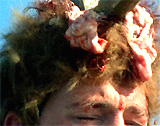 Dis-armed and Brain-Injured Aliens Attacking Derek on Cliff-Side  Robert Eating Brains of Decapitated Alien From Earlier  Giles Gesturing Toward Robert as He Was Attacked  Giles Knocked Out by Chef at Alien HQ 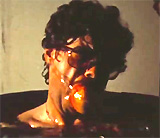 Giles Marinating in a Metal Drum  The Back of Derek's Opened Skull - Revealing His Oozing Brain  Lord Crumb (Doug Wren) - Disguised in "Human Form" 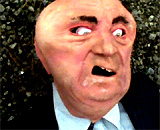    Lord Crumb and Other Aliens Losing Their Disguises  Derek with His Chainsaw   Derek's Chainsaw Massacre of the Aliens  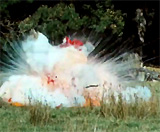 Errant Launched Rocket Struck a Sheep  House Transformed into Spaceship |
|||||||||||||||||||||||||||
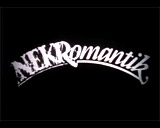
|
Nekromantik (1987, W. Germ.)
Director Jorg Buttgereit's first time feature film - this low-budget, cultish and controversial German gross-out, depraved horror film, was reviled and banned in many countries. It depicted necrophilia and other graphic activities and perversions - urination, bathing in bloody water, an autopsy, sex with corpses, rabbit cruelty (killing and skinning), cat disembowelment, graveyard sex, and decapitation by a shovel.
It started with a quote from V.L. Compton: "What lives that does not live from the death of someone else?" It also came with a disclaimer-warning in its opening frames for its many taboo-breaking sequences: 
WARNING: Some of This Film May Be Seen As "Grossly" Offensive and Should Not Be Shown to Minors!!! The two main characters who lived together exhibited extremely unusual behavior:
The film opened with the aftermath of a horrific car accident, being cleaned up by Rob, employed by Joe's Cleaning Agency (JSA) - notable for its symbol of a pentagram surrounding a skull and crossbones (Totenkopf) on the company's truck/van. There were views of the bloodied, deceased victims (in and outside the vehicle). After work, Rob returned to his apartment where he kept a collection of preserved remains in various jars filled with formaldehyde. He added to his assortment of human parts gathered from his day's work, stored on a multi-shelved rack.
Betty enjoyed bathing in bloody water, while Rob watched a televised interview with a psychiatrist speaking about phobias, including arachnophobia. Rob often had grotesque dreams/fantasies (one was of the slaughter of his childhood pet - a rabbit when he was a boy). In the next sequence, an unnamed apple-picker/gardener (Harald Weis) was accidentally shot in the neck and killed by his neighbor (Volker Hauptvogel) (who was aiming at birds), who then hid the body to avoid incrimination by depositing it in a pond. In his job duties, Rob was able to make off with the rotting cadaver and brought it home to Betty - and they fondled it lovingly. During a threesome with the corpse, Betty found pleasure in making love to it with a sawed-off piece of broom handle (outfitted with a condom) stuck in its groin as a makeshift penis. After the menage a trois sequence, Betty pounded a raw steak before frying it in a pan, for a meal served with a blood-red liquid. The decomposing body also served as a "toy" or wall decoration in their apartment (next to a centerfold) - plates were set under the corpse to catch dripping fluids. The next day, Betty performed cunnilingus upon herself with the corpse's head.
Everything took a downturn when Rob was fired from his job (for tardiness and sloppy work habits). Fed up with Rob's weak male personality, financial distress and frustrated by his termination, Betty fled (with the corpse). To reach new heights of degradation, Rob angrily resorted to:
After tossing a decapitated head and some entrails back and forth with a woman dressed in white, Rob enjoyed kinky graveyard copulation with a prostitute (atop a tombstone), but failed due to impotence. When she mocked and laughed at him for his sexual dysfunction, he strangled her and had sex with her corpse. The next morning, he also murdered an elderly man in the graveyard by chopping his head off with a shovel. In the film's final socially-isolated sequence, Robert simultaneously masturbated and committed disembowelment (hari-kiri) with a knife - culminating in an orgasmic semen-blood mixed expiration, a sexualized suicide. It was intercut with a reverse-motion ungutting of the rabbit from his previous dream. The last shot - ending in a freeze frame - was his grave plot (marked with a wooden cross bearing his name) being dug up by an unidentified woman (wearing stockings and high heels) - had Betty returned for his dead body to perform more necrophilia? |
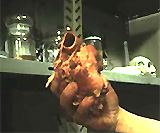 Human Body Parts Preserved in Rob's Glass Jars  Betty Bathing in Bloody Water  Rob's Daydream: Rabbit Cruelty  Video of Autopsy 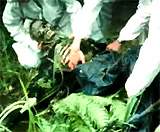 Rotting Cadaver of Gardener Found in Pond  Corpse Hung on Wall As Decoration, Next to Centerfold  Betty Engaging in Oral Sex with Corpse's Head 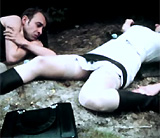 Murdered Prostitute in Graveyard  Decapitated Elderly Man in Graveyard 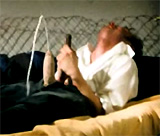  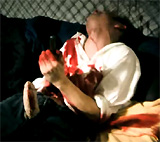 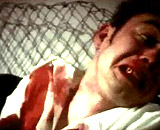 Rob's Simultaneous Masturbation (Semen and Blood) and Disembowelment Suicide  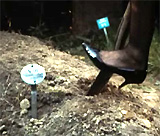 Rob's Graveplot Being Dug Up - by Betty? |
|||||||||||||||||||||||||||

|
The Last Temptation Of Christ (1988)
This controversial, profound, and challenging adaptation of Nikos Kazantzakis' 1955 best-selling novel of the same name was Best Director-nominated by the Academy of Motion Pictures Arts and Sciences. The author was almost ex-communicated from the Greek Orthodox Church as a result of writing the radical, revisionist book, and his work was frequently found on lists of banned books. The film was denounced as pornographic (for a non-explicit scene of Jesus procreating with his wife) even before its release, although the film clearly stated in a pre-credits disclaimer regarding the film's adaptation from the novel:
The resulting controversy hurt domestic ticket sales -- its box office was only $8.4 million, on a budget of $7 million. During one early screening in a Parisian movie theatre, a protesting fundamentalist French Catholic group threw a molotov cocktail at the screen and injured a number of people. Religious fundamentalists vehemently criticized, protested, boycotted, and picketed the film, with signs reading: "Don't Crucify Christ Again," "Stop This Attack on Christianity," and "Scripture Not Scripts." City leaders in Savannah, Georgia banned the film, and sent a signed petition to Universal requesting a widespread ban. The Blockbuster Video chain refused to carry the title, and one group suggested offering to buy the $7 million film from Universal in order to destroy it. Joseph Reilly of Morality in Media described the film as "an intentional attack on Christianity," and James Dobson of Focus on the Family warned ominously: "God is not mocked." Some complained about the rampant nudity portrayed in the film:
Many attacks were made on the way the film depicted Jesus' humanity. In the film's first sequence, a tormented, self-analytical, guilt-ridden and worried Jesus explained that he was collaborating with Rome by making wooden crosses for crucifixion so that they could kill his fellow Jews. He in fact assisted in the crucifixion of a zealous Jew accused of sedition against the Roman state. Full of self-contempt, Jesus also feared his Messianic destiny and hoped that by his actions, God would invoke his wrath upon him rather than love: ("God loves me. I know he loves me. I want him to stop....I make crosses so He'll hate me. I want Him to find somebody else. I want to crucify every one of His Messiahs"). Jesus also consistently expressed doubts about his nature, his Messiah nature, and his own mission in life. After sitting all day long in a brothel within sight of Mary Magdalene having carnal sex with numerous customers, Jesus told her - with guilt and sorrow - that he needed her forgiveness. Later, he turned his back on his own mother Mary, telling her "I have no family." The major controversy concerned the 'last temptation' visionary/hallucinatory sequence in the film's conclusion in which a very human and suffering Jesus (Willem Dafoe) was tempted by Satan (portrayed as a young androgynous guardian angel (Juliette Caton)) while he hung naked during crucifixion on the cross (while uttering as the camera turned sideways: "Father! Why have You forsaken me?"). He was offered an idyllic vision or dream by the angel, who claimed he had "done enough" after being tested for his loyalty by a pleased and merciful God. She cited the precedent example of Abraham being told by God to stop sacrificing his son Isaac.
His crown of thorns was removed, as well as the spikes through his feet and wrists - and the angel tenderly kissed his wounds. He was given life and led away from an empty cross while he asked: "I don't have to be sacrificed?... I'm not the Messiah." Onlookers at Golgotha were unaware of his departure. The vision included a normal earthly existence and mortal happiness, including the blasphemous idea of a sexual relationship with a woman. He was immediately married to tattooed prostitute Mary Magdalene (Barbara Hershey), who was earlier seen entertaining various clients in a brothel, where Jesus asked her for forgiveness.
She cleansed his bloody wounds as he laid naked in her arms, and then, in a non-exploitative sequence, Jesus made tender, physical love with her as she entreated: "We could have a child." After she became pregnant, she appeared partially naked when at full-term pregnancy.
But then, she abruptly passed away one day after a bright light shined on her. The angel told a sobbing Jesus that "God's killed her! God took her away when she was happy. Now she's immortal." He was assured: "There's only one woman in the world. One woman with many faces. This one falls, the next one rises." Mary, Lazarus' sister, would serve as "Magdalene with a different face" since she was carrying his son - and so he was taken to live with them. He confessed to the angel how he had made many mistakes: "I'm ashamed when I think of it...Of all the mistakes I've made. Of all the wrong ways I'd looked for God." Years later, Jesus met up with the proselytizing apostle Paul (Harry Dean Stanton), and asserted that he was the human Jesus: "I'm a man, like everybody else...I live like a man now. I work, eat, have children. I enjoy my life. For the first time, I'm enjoying it." Paul did not accept his claim and counter-argued that humanity's "only hope is the resurrected Jesus" through crucifixion, in order to save the world. Jesus argued back: "Those are lies. You can't save the world by lying." Paul ended their discussion with his trust in a different Jesus: "My Jesus is much more important and much more powerful." After Jesus had grown old and was on his deathbed, he had another intervention by his own betrayer, red-haired Judas Iscariot (Harvey Keitel) who called him the real traitor for not fulfilling his obligation to die on the cross:
Judas also claimed that the guardian angel was indeed Satan ("What angel? Look at her. Satan"), confirmed when she turned into a pillar of flames. Jesus realized the truth of Judas' words ("If you die this way, you die like a man. You turn against God, your father. There's no sacrifice; there's no salvation") - and that he must sacrifice his life by suffering on the cross for humanity's sake to save them. He painfully crawled through the burning city of Jerusalem (during an attack by the Romans) to again return to the cross, crying out to God to take him back and to "pay the price":
He rejected the temptation, and returned to die, finding himself back on the cross. In his final moments, he smiled and closed his eyes after he uttered the triumphant words:
The film then appeared to run out in the camera - illustrated by prisms of colored light, and then the burned film turned bright white. |
    Visionary Sequence On the Cross: Jesus Was Tempted by Satan (Portrayed as a Young Androgynous Guardian Angel (Juliette Caton)) 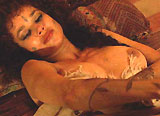  Mary Magdalene (Barbara Hershey) as Tattooed Prostitute  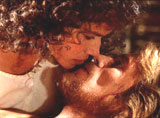 Sexual Relationship-Marriage with Mary Magdalene  Apostle Paul to Jesus: "Their only hope is the resurrected Jesus"  Back on the Cross: "It is accomplished!" Some Additional Objections to the Film:  In Nazareth, carpenter Jesus constructed crosses used for Roman crucifixion  Jesus pulled his own beating heart from his chest  Jesus seemed weak, afraid, and often tormented by God  Jesus kissed other men on the lips, including John the Baptist and Judas |
|||||||||||||||||||||||||||

|
Man Behind the Sun (1988, HK)
(aka Hei tai yang 731, or Men Behind the Sun)
This unrated (would have been NC-17 undoubtedly) provocative, unflinching and sickening documentary-style film (denounced by some as an exploitation film even though historically accurate) came from director T.F. Mou. It displayed many of the Japanese atrocities and perverse medical experiments committed toward guinea-pig human victims (Manchurian civilians in NE China) in Unit 731 (a biological warfare R & D experimental unit code-named Maruta) during WWII (and the Second Sino-Japanese War). The experiments were similar to ones committed by the Nazis in Europe. At the height of the conflict, Japan controlled the Korean peninsula, Taiwan, Hong Kong, Shanghai, and Manchuria. The Unit 731 complex was originally established in Manchuria by Japan in 1935 - 'Maruta' was also the name used to inhumanely classify subjects for the ghastly experiments:
It was claimed that Emperor Hirohito secretly ordered the inhumane lab experiments during Japan's aggressive period of empire-building, including the search for a contagious strain of the bubonic plague to unleash on the Chinese and on other enemies. The film opened with the quote:
Beginning in August 1936, the commandant of Unit 731, a biological and chemical warfare research facility, was General Shiro Ishii (Gang Wang) who performed grotesque experiments mostly on captive Chinese during WWII. One of the more appalling aspects of the experiments was that young Japanese boys in a Youth Corps were recruited and indoctrinated - to assist in the deplorable activities. Estimates were that 500,000 men, women, and children were experimented upon and became victims during the Unit's existence. The nationalities of the many victims were not only Chinese, however, but also included Russian, British, Mongolian, Korean and American prisoners. One atrociously graphic scene showed a traumatized Chinese woman (who had recently had her newborn cruelly smothered to death in the snow) the subject of experiments on extreme temperature. She was forced to thrust her deliberately frost-bitten frozen hands into hot water, and then had her flesh ripped off her hands to expose the 'de-gloved' skeletal bones. In another sequence, a group of prisoners were tied to wooden crosses in an open field and subjected to explosive bombs with ceramic (or porcelain) shell casings - as part of a flawed experiment to expose them to plague-infected fleas (with bubonic plague). Many of the prisoners were maimed or mutilated. Later, during a similar experiment with airborne bombs, those who were able to free themselves from their crosses and escape were either run over or shot. In another sequence set in a decompression or hyperbaric chamber, intense pressure caused a man's body to swell, causing his bowels and intestines to shoot out of his anus. In another segment, a woman and her child were gassed to death in a glass-enclosed chamber, while the Japanese commandant and other medical officials observed the ghastly effects. It was also criticized for its use of actual autopsy footage for 'live dissections.' The most egregious example depicted a drugged young, mute and naked Chinese boy who was operated upon only with the use of chloroform. His internal organs were extracted from his body while he remained alive. One of the doctors exclaimed how happy he was that they now had healthy organs to experiment with further: "Are you all satisfied? Well then, you have now got the heart and you've got the liver, and you've got the brain that you needed. All these organs from a living boy in puberty are difficult to come by. That was very successful." After the experiments, unneeded body parts of the dead were routinely incinerated.
Another scene was heavily criticized in which a live white cat was thrown into a chamber and ripped apart by a swarm of hungry rats. When news came that Nagasaki had been H-bombed in August of 1945, and the Russians were now fighting the Japanese, Gen. Ishii assembled his officers and ordered retreat and evacuation of Unit 731. He instructed his men to destroy all of their data and documents to prevent them from falling into the hands of the Russians. All of the Meruta were to be "exterminated" and the compound was to be destroyed and razed to the ground ("Nothing is to remain at all"). All "units" (and their families and dependents) were to commit suicide: "We have got to insure the secrecy of this facility!" - but then he agreed only in case of capture. The film ended with two other events just before the retreat of the Unit's squadron at the train station: a woman expired during childbirth, and a resistant young Chinese prisoner was impaled on a Japanese flag. An explanatory textual scroll before the end credits described how General Ishii was given immunity from war crimes prosecution in 1946 from the AOF (American Occupational Force) in exchange for the data acquired through human experimentation. By 1951, Ishii became part of the UN Command forces during the Korean War, where "bacterial weapons" appeared on the Korean battlefield in early 1952. |
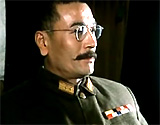  Commandant Gen. Shiro Ishii (Gang Wang)  Youth Corps Members and Other Troops  General Ishii with Japanese Concubine  Operations on Bodies    Frost-Bitten Hands Thrust into Hot Water - Exposing Skeletal Bones  Cat Attacked by Rats   Destruction of Unit 731 Lab With Jars of Body Parts  Young Meruta Boy Impaled by Japanese Flag During Squadron's Evacuation |
|||||||||||||||||||||||||||

|
The Cook, The Thief, His Wife & Her
Lover (1989, UK/Fr.)
Writer/director Peter Greenaway designed this cruel, over-the-top, truth-telling film as a metaphoric and allegorical criticism showing contempt for the wasteful and barbaric upper-class consumer society in Western civilization (specifically 80's Thatcherism and Reaganism). It established linkages between art, class structure, gastronomy and bodily functions, and sex and death. The film's tagline was:
The sensational film's putrescence, debasement and excesses (sadism, cannibalism, torture, fornication, puke, child abuse, and rotting fish and meat) and scatological themes (force-feeding of excrement (termed coprophagy), urination on victims, and more) forced the Motion Picture Association of America (MPAA) to give the film an "X" rating. After being denied an appeal, the film was originally released unrated by the producers, and then given an NC-17 rating by the time of its video release. An alternative R-rated version cut out about 30 minutes of footage. In all of cinematic history (as of 2020), it remained the fourth highest-grossing NC-17 rated film at $7.7 million, slightly behind Henry & June (1990) at $11.6 million; it was also behind the # 2 NC-17 film, Showgirls (1995) at $20.4 million, and the # 1 film Last Tango in Paris (1973) at $36.1 million. It told about a number of real (but also symbolic) characters, who spent much of their time at a trendy haute cuisine London restaurant called Le Hollandais:
Albert dined and presided over a sumptuous banquet every night (over a nine evening period). He held court around a table where he talked about food, excrement and sex, and surrounded himself with various lackeys and henchmen. He harrassed and brutalized both the staff and patrons of the restaurant. The huge restaurant that was the centerpiece of the film was composed of four rooms or sections, each of which was color-coded:
To escape from her abusive husband, the adulterous and unfaithful Georgina snuck away for hungry trysts with her Lover (during visits to a rest-room stall, kitchen and bakery pantry, and in a freezer, filmed with unflattering light). When Albert came upon his wife hiding in the stall with Michael, he asked: "What are you doing in there, Georgie? You playin' with yourself? That's not allowed. That's my property, you're not allowed to fiddle with it. Now come on, open the door, I'll show you how to wipe yourself." On a separate occasion after having sex with Georgina, Michael complimented her eyes, and she responded: "And you have a beautiful prick, Mr. Gynecology." Albert learned of their affair when pimped prostitute Patricia (Emer Gillespie) divulged that Georgina and the quiet man at a nearby table always went off together to secretly have sex:
Enraged, he stuck a fork into Patricia's cheek. Soon after, he went after them, forcing the two to retreat (with restaurant help) into the back of a meat truck with putrid smells of rotting food. They were driven to Michael's home/book depository where they were hosed off. The brutal Albert decided upon savage, cannibalistic revenge upon the man, and ironically stated and foreshadowed:
Michael was killed by force-feeding him with pages from his favorite book. After her lover's death, Georgina asked the cook Richard to recall for her what he had witnessed about their affair, to make it more real for her - and he reminisced: "I saw him kissing you on the mouth, on the neck, behind your ear. I saw him undressing you. I saw him kissing your breasts. I saw him put his hand between your legs." She also asked what he had witnessed she had done: "I saw you kiss him on the mouth. I saw you lying under him on the floor of the pantry. I saw him take you from behind. I saw you take his penis in your mouth." She began to sob. Then, Georgina begged for the reluctant Cook to help her - to bake up her lover's corpse (she even tried to persuade him by offering herself):
The Cook was appalled and thought: "Do you have some idea that by eating him he can become part of you? You can't believe that by eating him you can always be together!" She explained her motive was revenge: "I'm not eating him. Albert is." She hosted a private, Friday night function with Albert the prime guest of honor. He was disgusted when he arrived and saw Georgina - he viciously threatened her: "What brings you here, you bitch! I'm very surprised you so brazenly show your face here, you slut... I'll bloody kill you for what you did to me!...And don't think I'm taking you back. I'll make you pay, you slut. Your bottom's going to be very, very sore for weeks. No more books for you, girl. You're staying in under lock and key. There's gonna be no more books or prick-sniffing for you, girl." She only greeted him: "Happy anniversary, Albert," and then clarified: "It's an anniversary that I shall always celebrate, even if you won't. And you won't." She described how she had 'cooked up' a "present" for him. There were other guests in attendance who would soon appear -- "And Richard has cooked it for you. Under my instructions...Knowing how you like to eat. Knowing how you like to gorge yourself. And we've brought a few of your friends around." A formal procession of people (those Albert had wronged) brought in the veiled body on a large platter for dinner - his "special treat." She removed the cover on the platter - and there was a slow-pan up the length of the cooked corpse as Albert gasped: "Georgie! Jesus! God!" She calmly responded: "No, it's not God, Albert. It's Michael, my lover. You vowed you would kill him, and you did. And you vowed you would eat him. Now eat him." She forced him to eat the warmed-up cadaver ("What's the matter? You have your knife and fork. You do know how to use them. Or have all those carefully-learnt table manners gone to waste?"). Albert pulled out his pistol, but was disarmed and the gun was passed around to Georgina, who then added as she held him at gunpoint:
Stunned, Albert took a forkful bite and vomited (he had finally consumed enough), as The Wife encouraged him to eat more: ("Go on, Albert, eat. Bon appetit, Albert. It's French") - and then she shot him to death in the head. He was propelled backward as she condemned him as a "Cannibal." A red curtain closed to end the film. |
 The Wife and Lover In a Restroom Stall  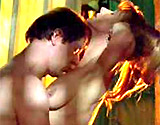   Sex in Various Back Areas of the Kitchen  Hiding in Michael's Bookstore After Being Found Out  Abuse Towards Patricia (Emer Gillespie) Who Divulged to Albert that Georgina "Screws Around"   Procession into Restaurant    Lover on a Platter  Georgina: "Eat, Albert!!"   The Thief Forced by the Wife (at Gunpoint) to Consume The Cooked Body of Her Lover  Georgina: "Cannibal" |
|||||||||||||||||||||||||||

|
Do The Right Thing (1989)
African-American writer/director Spike Lee's third (and breakout) feature film was this complex, angry and unapologetic social protest film about racism, racial pride, intolerance and oppression, class struggle and violence. This controversial and incendiary independent film received a Best Original Screenplay Academy Award nomination for Lee. Although it was feared by film critics that the film would cause and incite similar responses from black urban-dwellers, this proved to be a misrepresentation of the facts by the film's detractors, that dubbed the film "irresponsible." It told about racial tensions that eventually erupted into a riot on a sweltering summer day in the multi-ethnic Bedford-Stuyvesant neighborhood of Brooklyn. It was presented with vibrantly bright colors, realistic and goofily-named characters and dialogue, a supplementary "Greek chorus" of black men on the corner commenting on the day's events, and energetic editing and quasi-documentary, cocked camera angles. The multi-ethnic cast of the film provided three-dimensional characters and day-in-the-life stories, and featured the early career work of Samuel L. Jackson (as DJ Mister Senor Love Daddy) and Rosie Perez (as demanding single mother and feisty Hispanic girlfriend Tina). During the opening credits, Public Enemy performed the film's hard-edged anthem and title rap song, "Fight the Power" accompanied by a heavily-stylized dance sequence - foreshadowing the coming emergence of rap and hip-hop music into the mainstream culture. In the opening scene, velvet-voiced DJ Mister Senor Love Daddy (Samuel L. Jackson) vehemently woke up the Bed-Stuy neighborhood with his "We Love Radio" sounds provided with the day's forecast:
The tension began to escalate in this slice-of-life film because of a complaint by a militant activist neighborhood patron named Buggin' Out (Giancarlo Esposito) that there were no pictures of 'brothers' on the "Wall of Fame" - "Hey, Sal, how come they ain't no brothas on the wall?" - there were only photos of famous white Italian-Americans in the white-operated and owned Italian "Famous Pizzeria" restaurant run by Salvatore "Sal" Frangione (Oscar-nominated Danny Aiello). This was followed by his demanding attempt to stage a neighborhood boycott of "[Sal's] fat pasta ass"; Sal yelled back: "You're gonna boycott me? You haven't got the balls to boycott me. Here, here's your boycott, up your ass. You've got a boycott." One of the neighbor's residents, Radio Raheem (Bill Nunn) was always accompanied by his gigantic boom box playing Public Enemy and the hip-hop anthem Fight the Power. He told a story of LOVE and HATE, illustrated by his two giant-sized gold rings (referencing the film The Night of the Hunter (1950)):
A montage sequence was composed of a profane stream of ethnic and racial slur-expletives and insults - with each of the individuals speaking directly to the camera and breaking the 4th wall --
A top-down convertible was doused by an open fire hydrant, after the Italian-American driver had specifically shouted and threatened at the blacks not to spray him. During an infamous ice cube melting scene with girlfriend Tina (Rosie Perez) on a hot afternoon, Mookie wanted to have quickie sex (the "nasty") in her hot apartment bedroom, and then quickly leave afterwards. She complained: "If you think I'm gonna let you get some, put your clothes on, and leave here, and I won't see your black ass for another week, you must be bluffin'?" He proposed instead: "Let's do somethin' else." He had her stand on the bed and strip naked ("Take your clothes off"), while he went to the refrigerator to retrieve two trays of ice cubes. He methodically rubbed them over her naked body (forehead, lips, neck, kneecaps, elbows, thighs, and breasts) in full-closeup view, as he worshipped her body parts: (""Thank god for the lips...Thank god for the neck...Thank god for kneecaps...Thank god for elbows...Thank god for thighs...Thank god for the right nipple. Thank god for the left nipple. Ah, she likes, she likes, she likes"). Tense scenes were prefaced by Sal's baseball-bat destruction of Raheem's blasting boom box inside the pizzeria. This led to a massive altercation at the pizzeria, ending with the brutal choke-hold police murder of Radio Raheem, the apprehension of Buggin' Out, and Mookie's incitement of a fiery riot by hurling a trash can through Sal's storefront window, causing further racial divide and police brutality, and the burning down of the pizzeria (with fiery flames licking the 'Wall of Fame'). Two contradictory quotations ended the film, one from Martin Luther King, Jr. advocating non-violence, and the other from Malcolm X advocating violent "intelligent" self-defense in response to oppression. |
 "This is Mister Senor Love Daddy" - Today's Forecast   "The Wall of Fame" in Sal's Pizzeria  Radio Raheem's (Bill Nunn) LOVE - HATE Rings  The Beginning of the Scene of Racial Epithets - Directly Addressed to the Camera  Spraying of Convertible  Mookie's (Spike Lee) Girlfriend Tina (Rosie Perez)  Ice-Cube Melting on Tina's Chest 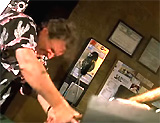 Sal's Destruction of Boom Box 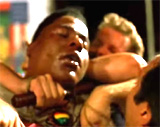 Murder of Radio Raheem  Mookie's Trash-Can Hurling Through Sal's Storefront During Riot  Pizzeria in Flames |
|||||||||||||||||||||||||||
(chronologically, by film title) Intro | Silents-1930s | 1940s-1950s | 1960-1961 | 1962-1967 | 1968-1969 1970-1971 | 1972 | 1973-1974 | 1975 | 1976-1977 | 1978 | 1979 1980-1982 | 1983-1986 | 1987-1989 | 1990-1992 | 1993-1995 | 1996-1999 2000-2002 | 2003-2005 | 2006-2009 | 2010-present |